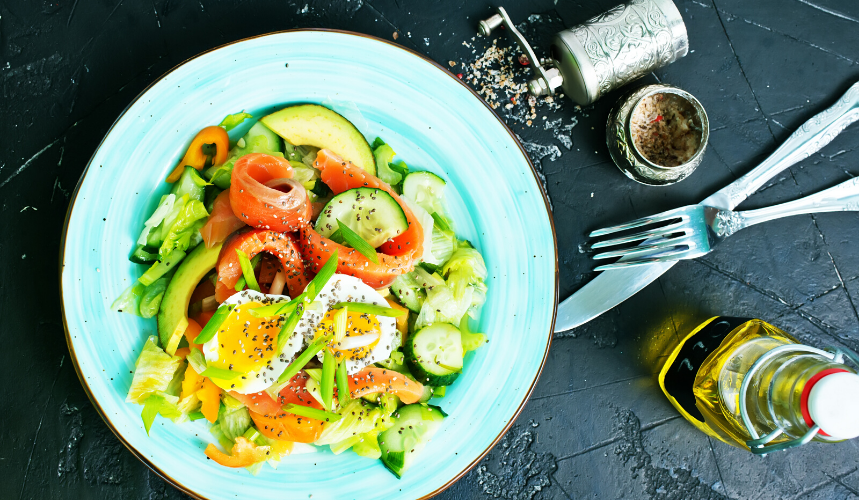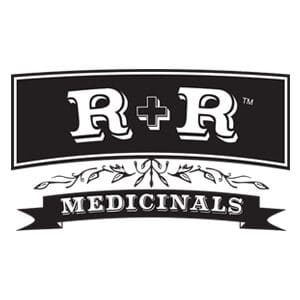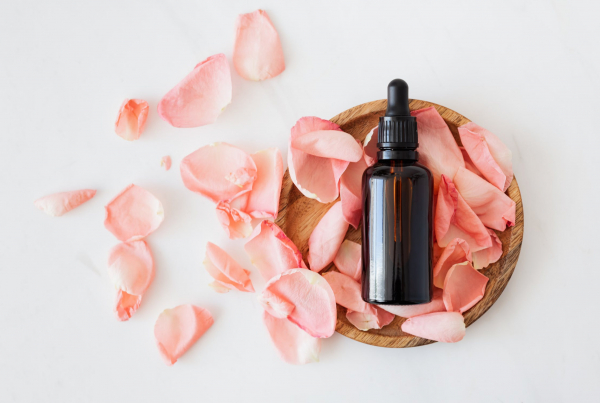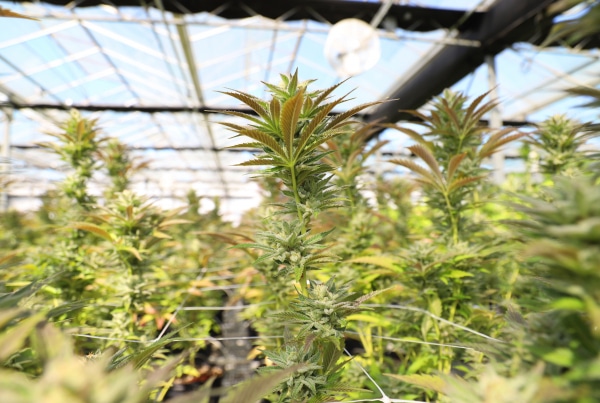
These days CBD is everywhere, and it’s not just in tinctures. You can spray it, smoke it, and even lather it on. Lately, though, the CBD edibles trend has really taken charge. You can buy edible CBD gummies, cakes, cookies, granola bars, protein powder, and even find local coffee shops and bakeries with CBD-infused goods.
For the ultra-thrifty (and the ultra-picky) this begs an important question: Can you cook with CBD at home? And if so, what can you make?
The answer is, absolutely! And the options are virtually limitless—plus, you don’t need to be a professional chef to do it!
That’s not to say there isn’t some skill involved in cooking with CBD. You need to take time to plan your recipe carefully and pay close attention to things like cooking temperatures (spoiler: You probably shouldn’t deep fry with it!) and dosage calculations.
Sound confusing? No worries. We’ll cover everything you need to know about cooking with different CBD products, choosing compatible flavor combinations, cooking temps, and more. But first, let’s answer the most important question of all—why would you want to cook with CBD in the first place?
Benefits Of Consuming CBD
Eating CBD is only one way to reap the benefits of the active cannabinoid, but it’s quickly becoming the most popular. Why? Because CBD edibles are delicious! And because they deliver all of the same benefits of other CBD products, like tinctures or capsules.
That means that whether you use CBD for anxiety, depression, pain, or another condition, using CBD in your recipes at home is still a great way to reap these benefits.
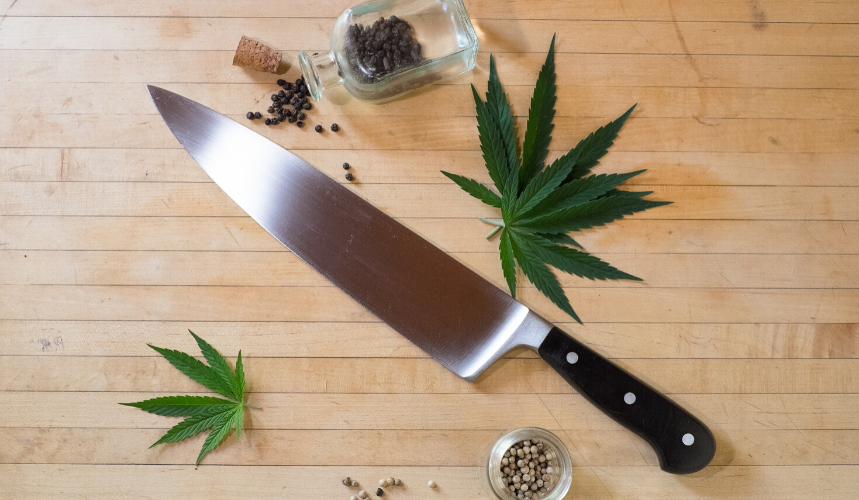
Other benefits of cooking with CBD include:
- Maintaining complete control over potency and dosing
- Disguising the flavor of CBD in your favorite foods
- Saving money by buying CBD-infused cooking oil or bulk CBD instead of pre-made edibles
- Creating new recipes and changing up your CBD routine so it’s never boring
- Expanding past gummies and candies to hearty CBD-infused snacks and meals, like granola bars or pasta
- Making CBD edibles at home to share with friends and family (with their consent, of course!)
If this sounds like your (CBD-infused) cup of tea, check out our step-by-step guide to cooking with CBD, below.
How To Cook With CBD
If you know your way around the kitchen, cooking with CBD may come pretty naturally. This is especially true if you choose a CBD product designed for cooking, like CBD-infused cooking oil.
Still, anyone can learn to cook with CBD, even if they don’t have a natural culinary gift. If you’re one of those people that has to pull the mac and cheese box from the trash to double-check the recipe, have no fear! This five-step process will have you whipping up hemp-filled treats in no time!
Step one: Choose a product
There are several different ways you can use CBD in your kitchen, and each offers different benefits and drawbacks. Typically, any CBD tincture or isolate powder can be used to cook CBD-infused goods. The potency and flavor of these products vary greatly, so you should give some forethought to each product and how it can be used.
Naturally, flavored oils will offer more expansive recipe opportunities, while flavored oils may help hide the flavor in the dish you choose. We’d bet that a plain full spectrum tincture would pair well with a savory pasta sauce while a citrus-flavored tincture would make stellar lemon cookies.
As the market has shifted towards CBD-infused edibles, leading brands have stayed ahead of the game by offering oils and cooking ingredients infused with CBD. Some brands, like Herb & Olive, have been making premium cooking oil for decades, and later decided to add hemp to the mix. Grabbing a bottle of CBD-infused Extra Virgin Olive Oil is a great way to keep your kitchen stocked with CBD.
Alternatively, you can also make CBD-infused edibles the same way that cannabis-infused edibles are made—with raw hemp flower. This is a bit more labor-intensive, and you’ll likely end up with a stronger herbal flavor. Still, if you want to give it a go, check out our guide for making cannabis-infused edibles.
Choosing a product that meets your needs for flavor and potency is important, but it’s even more important to understand how to choose a trustworthy, high-quality brand. Ensuring the quality of your starting product is crucial to creating delicious, effective CBD-infused goods at home.
Step two: Find a recipe
After you choose a CBD product to cook with, figure out what kind of CBD-infused dishes you want to make and find a recipe. You can use almost any recipe that has oil or fat content and doesn’t require extremely high temperatures (see step three). Virtually any baked good, dinner dish or snack recipe will work for making CBD-infused foods, so you can get really creative!
If you aren’t a confident cook, start with something simple. For instance, a boxed good (like mac and cheese) that requires oil can be used with CBD cooking oil or a measured tincture dose to make an easy CBD-infused dish! After you get the hang of cooking with CBD, you can always expand your horizons and explore more complicated dishes.
If you’re looking for inspiration, you can pick up a CBD cookbook (yes they exist!) from Amazon. We’d suggest The CBD Cookbook for Beginners by Mary J. White, or The CBD Kitchen by Leah Vanderveldt.
Step three: Temperature (find reference)
Cannabinoids are a bit finicky when it comes to heat, so special considerations are required when you cook with CBD. On one hand, low heat may make the oil more effective by changing CBDa to CBD. This process is called “decarboxylation” or “decarbing.” Many CBD products are decarbed during manufacturing to boost the CBD content of the final batch.
On the other hand, cannabinoids begin to degrade at high temperatures. The exact temperature resistance of CBD is variable, but evidence suggests that it begins to evaporate at temperatures higher than 320 degrees Fahrenheit (PDF).
In other words, you should cook with CBD at low temperatures to avoid degrading the concentration of the CBD product you choose. In most cases, you can just adjust the temperature and cook time of any recipe to meet these needs. For instance, cookies that bake at 350 degrees for 15 minutes may cook at 315 degrees for 20 minutes instead.
If you aren’t sure how to make these adjustments, you may consider backing up to step two and choosing a recipe that calls for a lower cooking temperature. You’ll definitely want to avoid recipes that call for deep frying or pan frying with your CBD oil since temperatures that high will likely result in the loss of CBD potency and terpenes. Heating CBD oil too high may also result in a bitter aftertaste.
Step four: Calculate your dosage
After you’ve chosen your recipe and product, you’re almost ready to start cooking. First, carefully cross-examine your desired dosage-per-serving and the number of servings the recipe will make. This will help you decide how much CBD you should add.
If you’re making a dozen muffins and you want each to have about 10 mg of CBD, you’ll want to add 120 mg of CBD to the batch. Here’s where carefully choosing your CBD product comes into play—if you’re using CBD-infused cooking oil, you shouldn’t add more oil than the recipe calls for. Instead, you may up your CBD dose by adding a dropper full of your favorite CBD tincture.
Alternatively, if the recipe calls for one cup of oil, but that’s more CBD than you need, add in the desired amount of CBD-infused oil and then finish off with regular cooking oil instead.
Step five: Prepare and store accordingly
After you’ve configured your recipe, temperature, and CBD dose, you’re ready to whip away in the kitchen. Watch your temperatures closely so they don’t get too hot, or you may end up with a bitter, ineffective mess.
Make sure you store your creations properly—perishable food should be refrigerated. Other things may be okay in an airtight container at room temperature for a few days. You can freeze leftover portions (depending on the recipe) to make them last much longer, too!
Six Tips For Cooking With CBD
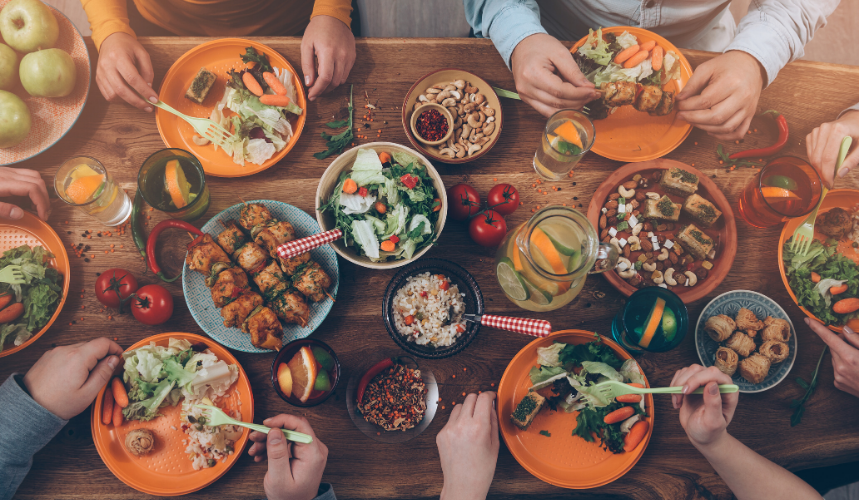
Ultimately, cooking with CBD isn’t all that different from the way you cook every day. Keep in mind that learning to cook CBD-infused goods is a process, so if it doesn’t turn out the way you’d like, you can always try again.
Still, there are a few precautions that can help make your CBD-infused culinary experience a success—or at least minimize the mistakes you may make along the way. Try implementing these tips when cooking with CBD:
1. Start small
One of the most important tips we can give for cooking with CBD is to start low and slow. This is important if you’re new to taking CBD, but also if you’re an experienced CBD user who’s new to cooking with CBD.
First, small doses can help you ease into a new CBD routine until you figure out how much CBD you need to get relief. But most importantly, using a small amount while learning how to cook with CBD will minimize waste. If your recipe doesn’t turn out, you lose less of your precious product. We also recommend starting with an easy recipe to cut the chances that something goes terribly wrong! You may even consider making a “half-batch” or cutting your recipe in half the first time around.
2. Stir, then stir again
When you cook with CBD, stirring is essential! You may need to stir even more than you would if you weren’t cooking with CBD. After you add your CBD oil to your recipe, stir it at least twice as long as the recipe suggests in order to evenly distribute the CBD to the entire dish. The end goal is for every serving to have a similar dose of CBD, so stir away!
Note: Some recipes, like yeast dough and some baked goods, can be overworked, which will cause them to fall flat when cooking. If the recipe warns against “overworking” the dough or batter, it may not be a good candidate for cooking with CBD.
3. Choose flavors wisely
If you want your CBD food to taste great, you can take it past the “CBD in everything” logic and try to determine which recipes will best compliment the flavor of your CBD product-of-choice. This is especially important if you’re making CBD edibles for someone with a picky palate since some flavors will do a better job of hiding the hempy flavor of many full-spectrum CBD products.
More refined CBD oil may have less flavor, and pure CBD isolate products are usually tasteless. This makes them a good choice for a wide range of recipes, including those with sweet, savory, or more delicate flavors. Of course, refining the product to remove the flavor may also remove most of the beneficial compounds (like terpenes) found in full-spectrum hemp products.
Less refined CBD oils are more “natural” and will usually have a more colorful cannabinoid and terpene profile, as well as more vitamins and amino acids from hemp. These oils pair better with heavy flavors, like a dish with strong spices and herbs. Raw or less refined hemp oil may also complement strong flavors like dark chocolate, too.
Pro tip: If you need help with flavor pairing, find a CBD product that’s designed for cooking to cut down on the guesswork. If you’re familiar with cooking with olive oil, you may try Herb & Olive’s CBD Extra Virgin Olive Oil in place of your usual oil.
4. Consider making cold foods
Because of the temperature barrier, some recipes just won’t work well for cooking with CBD oil. This is especially true for fried goods that require especially high cooking temps. If you want to alleviate the worry of degrading CBD at too-high temperatures, consider making cold dishes.
This could include food items that don’t need to be cooked, like guacamole, salads, or dishes where the CBD oil can be easily added after the cooking is done. Pasta salad, for instance, can be cooked first and the CBD oil can be added to the dish after it’s removed from the heat.
5. Invest in a thermometer
If you’re adamant about making hot dishes with CBD, you may consider investing in a cooking thermometer. According to current research, CBD begins to degrade at 320 degrees Fahrenheit, so you should use your thermometer throughout the cooking process to keep an eye on the temperature of your food.
Keep in mind that your oven’s temperature gauge may be slightly inaccurate, so always double-check with your thermometer to protect the integrity of your CBD oil.
We’d suggest getting something with a long wire probe like the ThermoPro TP-16 Thermometerso you can use it in the oven. It also has preset temperature settings, an alarm, and more features that will let you use it with “normal” cooking as well, and is very affordable.
6. Store CBD properly
Your CBD oil product (whether it’s cooking oil, tincture, or isolate powder) likely needs to be stored in an airtight container away from direct sunlight. Cannabinoids are naturally sensitive to heat and light, and exposure to certain elements can lead to low potency.
Usually, storing these products at room temperature is fine. Some CBD-infused food items for cooking may need to be stored in the refrigerator. The best way to keep your CBD products fresh is to check the label and store them accordingly.
Five CBD-Infused Recipes To Try
The possibilities of what you can cook with CBD are virtually endless, which is exciting, but definitely doesn’t make it easy to choose. If you’re lost on what to make, no worries! Check out the delicious CBD-infused recipes below:
Homemade Pizza
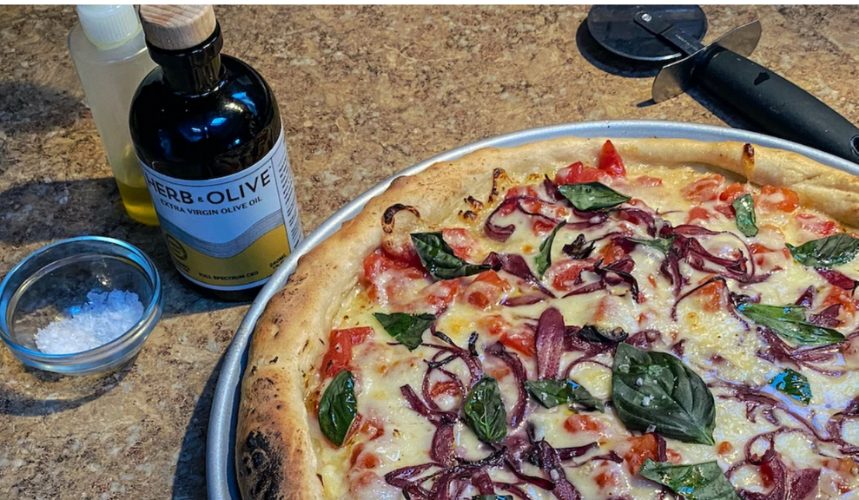
This CBD-infused pizza is anything but basic. It starts with homemade pizza dough and finishes off with serrano peppers, dried hibiscus, mozzarella cheese, and CBD EVOO. Serves two-four people.
Avocado Toast and Poached Egg
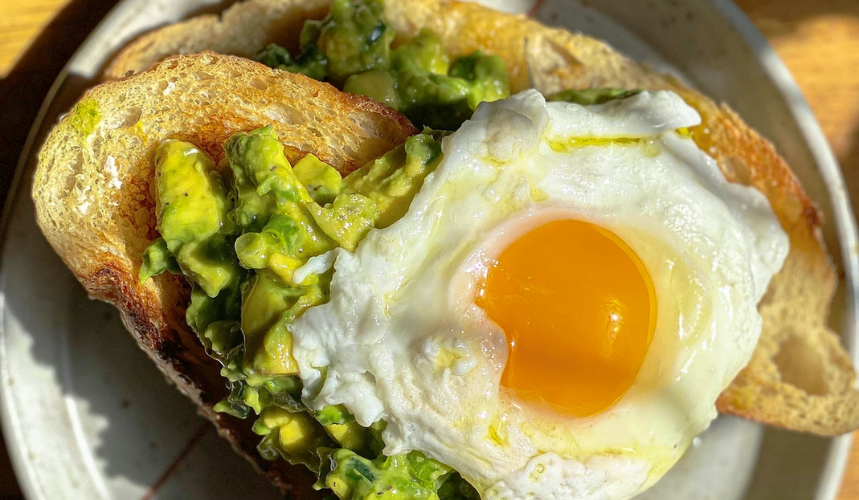
A hemp-infused twist on a modern delight—toasted sourdough topped with avocado and a perfectly poached egg, drizzled with CBD-infused EVOO.
“Dirty Enough” Martini
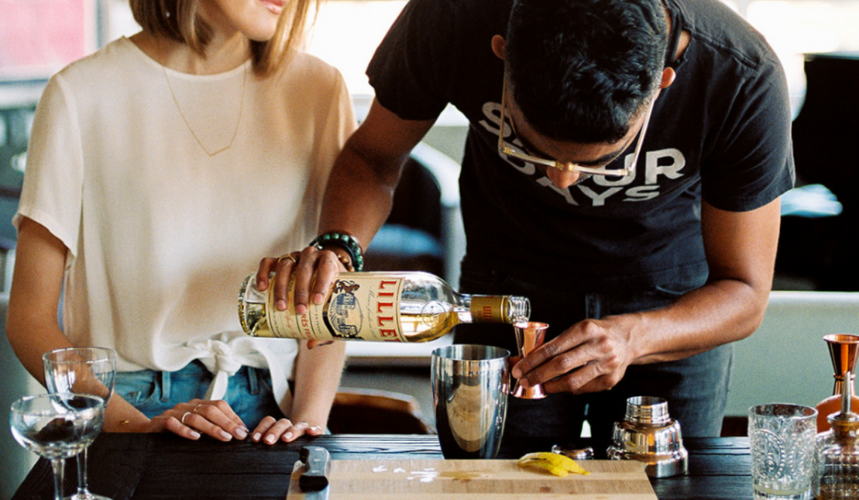
Have you ever wondered if you can infuse a martini with CBD? Now you can! Check out this “Dirty Enough” Martini recipe for a step-by-step on how to make this CBD EVOO-washed vodka drink.
Snapshot Salad
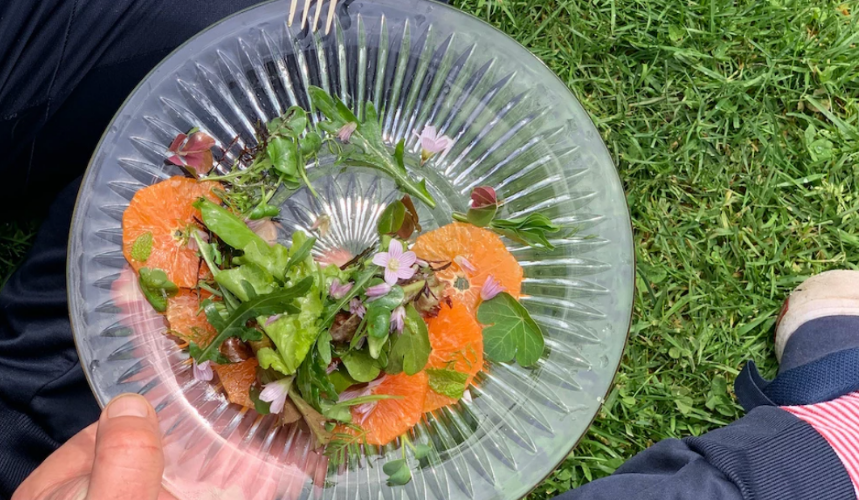
This bright, fruit-and-veggie salad will add the CBD zing you need to breakfast, lunch, or dinner. Just toss it together and drizzle on the tangy, CBD EVOO-infused dressing!
Colorful Cauliflower Salad
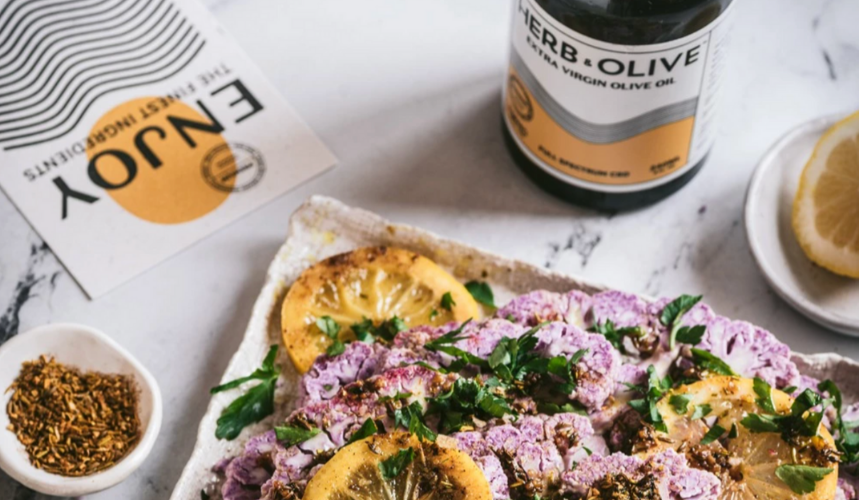
This garlic and CBD EVOO-infused cauliflower dish comes together in a pinch, and it’s just as eye-catching as it is tasty!
Key Takeaways
Cooking with CBD is a great way to make CBD edibles that are designed to meet your specific needs, and can help you cut costs and always keep a delicious CBD dose on hand.
CBD may work well in lots of recipes, so long as they have some oil or fat content. However, you’ll want to avoid recipes that require high temperatures since CBD is not very tolerant of temperatures of 320 degrees Fahrenheit.
There are different types of CBD products, like oils and powders, that can be used for cooking with CBD. Products designed for cooking, like CBD-infused cooking oils, make it even easier.
Start small and read all the directions carefully to minimize mistakes. Most importantly, have fun and don’t give up. With persistence, you’ll definitely find your CBD kitchen groove!


